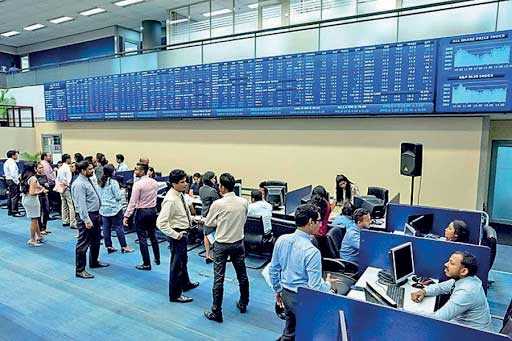The high-flying and world’s best performing last week Colombo stock market yesterday suffered its worst crash in history with Rs. 245 billion in value wiped off as investors and analysts pinned the blame on regulators whilst profit-taking contributed to the downfall too.
The All Share Price Index plunged by 561.7 points or 6.56% and the S&P SL20 dived by 251.7 points or 7.3%. Turnover was relatively high still at Rs. 7 billion with 232.8 million shares traded. Market capitalisation yesterday was at Rs. 3.49 trillion, down from Rs. 3.74 trillion. Despite the crash, YTD gain of ASPI remains healthy at 18% and 20.8% by S&P SL20 thanks to the stellar performance in January.
The market was halted twice as S&P SL20 suffered crashes of 5% in two separate occasions, leading to a suspension of trading for half hour to cool investor anxiety.
Biggest contributors to ASPI’s fall yesterday were LOLC (40.5 points) JKH (38.5 points), Vallibel One (34.8 points), Carsons (25.7 points) and Expolanka (22.4 points).
Some investors and analysts blamed the regulator Securities and Exchange Commission (SEC) and the Colombo Stock Exchange (CSE) for their directive and circular last Friday which signalled the duo was stepping up surveillance on broker credit.
However, independent analysts claimed the directive/circular wasn’t harsh but information that was previously provided on a monthly basis now have to be provided weekly by brokers. This was as part of prudence given the unprecedented trading activity as turnover in January was a record Rs. 185.7 billion surpassing collective three months figure worth Rs. 179 billion in last quarter of 2020.
There was a concern that with low interest rate, brokers and investors were facilitating a greater degree of margin trading or credit facilities. However, brokers denied this allegation, saying that current best practices place healthy limits and pinned yesterday’s downfall to CSE’s original circular mistakenly listed seven stocks including fundamentally sound LOLC Holdings, Expolanka and Browns Investments for brokers to reveal credit exposure. These stocks had been identified based on turnover/volume.
After agitation from some companies over the flaw in the circular, the CSE in a fresh memo to brokers said the list of securities set out under ‘Additional Information on Debtors Over T+3 Balance of Specific Securities’ in the original circular “appears to have caused misperception” in the market regarding the specific listed companies.
“The purpose of highlighting the said securities was to obtain information regarding credit exposure to such securities applicable to each stockbroker firm,” said the CSE, requesting brokers disregard the list of securities in the original circular.
CSE said what was expected from brokers was top 10 securities on which credit has been extended to clients by the firm as at 29 January. Additionally, a list of all clients with a Debtors over T+3 balance having any of the said top 10 securities in their respective portfolios as at 29 January must be furnished as a breakdown.
Interestingly the SEC directive to the CSE didn’t list any specific securities. The error was on the part of the CSE.
The first circular gained lot of traction and discussion among investors over the weekend and the negative perception signalled what was to come with ASPI and S&PSL 20 declining by 1% and 2% respectively on Monday and crashing yesterday.
Some also linked negative sentiment to the Government snubbing India and Japan and the tripartite deal signed between the countries on the crucial East Container Terminal by deciding to develop it via Sri Lanka Ports Authority (SLPA).
The move comes at a time when the country is starved of foreign exchange and investment in addition to facing severe debt servicing challenge. The original tripartite agreement signed in May 2019 would have resulted in over $ 600 million in new private sector investment.
First Capital said the market witnessed the highest intraday crash in the history on the third consecutive day of downfall due to the profit-taking of retailers.
“Index experienced a strong downtrend since the beginning of the session, triggering two market halts during mid-day, due to the S&P SL20 falling by 5% & 7.5%. Market recorded its intraday low of 7,837 before closing at 8,005 losing 562 points,” First Capital added.
Asia Securities said “encouragingly, following two circuit breakers, the indices were on the recovery towards the latter part of trading as investors were seen taking positions on attractive valuations that presented themselves, ahead of a strong earnings season.”
NDB Securities said the ASPI continued to extend previous days’ losses.
It said high net worth and institutional investor participation was remained subdued for the day.
Mixed interest was observed in LOLC Holdings, Browns Investments and Royal Ceramics, whilst Retail interest was noted in Vallibel One, Expolanka Holdings and Sampath Bank.
Capital Goods sector was the top contributor to the market turnover (due to Vallibel One and Royal Ceramics), whilst the sector index lost 9.43%. The share price of Vallibel One moved down by Rs. 14.00 (17.43%) to close at Rs. 66.30. The share price of Royal Ceramics declined by Rs. 63.25 (16.51%) to close at Rs. 319.75.
Diversified Financials sector was the second highest contributor to the market turnover (due to LOLC Holdings), whilst the sector index decreased by 7.36%. The share price of LOLC Holdings decreased by Rs. 37.25 (7.39%) to close at Rs. 466.50.
Browns Investments and Expolanka Holdings were also included amongst the top turnover contributors. The share price of Browns Investments lost Rs. 0.30 (4.48%) to close at Rs. 6.40. The share price of Expolanka Holdings recorded a loss of Rs. 5.00 (9.75%) to close at Rs. 46.30.
Separately Keells Food Products announced an interim dividend of Rs. 7.00 per share.
Net foreign selling amounted to Rs. 179 million bringing the year to date figure to Rs. 9.07 billion.
Asia Securities said estimated net foreign buying topped in EXPO at Rs. 6.7 million and net foreign selling topped in SAMP at Rs. 55 million.
(FT)

